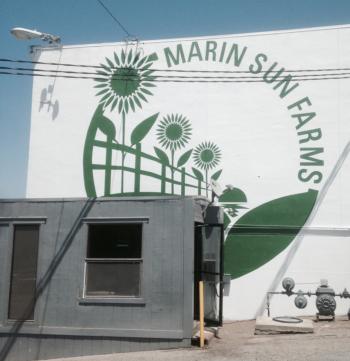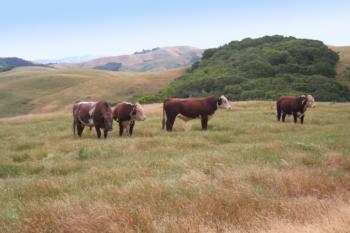Interview with David Evans, Marin Sun Farms
By David Lewis
On Friday, April 3rd, I had the chance to catch up with David Evans, local rancher and operator of the Bay Area’s only “abattoir," or slaughterhouse. I wanted to talk with him about his business, Marin Sun Farms, and its status now that it has acquired the Petaluma slaughter facility. The following transcript shares our discussion.
GIM News: 2014 was an eventful year for Marin Sun Farms, with the purchasing and consolidation of operations at the Petaluma facility. What was going through your mind the night before the purchase was finalized?
DE: What could go wrong, thoughts of how could this not happen gave way to what are the next steps in a long list of next steps. I realized immediately that this slaughter facility, under Marin Sun Farms ownership, would be the gateway for local meat supply to reach California markets more seamlessly, and at a time when demand is soaring and supply is burgeoning. The last remaining Bay Area meat processing facility would be the funnel by which most high quality California meats would flow to market.
GIM News: You have described purchasing the Petaluma slaughterhouse as a “dream come true.” We will come back to that endeavor shortly. Before we do, can you take us back a few years and share when the vision of owning and running a full service abattoir came to you?
DE: Returning from college, I worked two years on the family farm. That was when my passion for natural resource and pasture management grew and led me to a grass-fed model of beef production. It took three years of R & D (research and development) before I had a product I could directly sell to customers. That was around 2003. From that point on, the dream or the need for a processing facility was always there. Grass-fed meat was exploding on the market and the real road block for delivery was processing. I shifted my attention from production to processing and the level of control that having a harvest facility would provide.
GIM News: Now that Marin Sun Farms has the facility in Petaluma has your mission changed?
DE: Marin Sun Farms’s mission is to contribute in building a more sustainable future through local food and building resiliency within local foodsheds. Marin Sun Farms has accomplished this by investing heavily in processing; being positioned between livestock and market to facilitate that connection and become a gateway for what we term 100% Grass Fed, Pasture Raised, and Food-shed sourced meats. The abattoir was the scarce resource and the most difficult to obtain when envisioning what I wanted to accomplish with Marin Sun Farms.
GIM News: As a community of livestock ranchers, there has been a perennial discussion about bottlenecks in processing of meat products, from harvesting, to cut and wrap, to distribution. Do you see bottlenecks currently and if so how can they be removed?
DE: With Marin Sun Farms taking over the slaughterhouse and adding carcass fabrication, cuts, packing, there is now a readily available option to accomplish all of the needed service being demanded. Because we only have a limited number of processing facilities, there is an inevitable bottleneck, but no rancher is getting turned away, capacity is yet to be fulfilled in multiple facilities and the area/region does not have enough supply to currently support any additional slaughter facilities.
GIM News: As follow-up, what is the status of Marin Sun Farms’ plans for mutli-species and organic processing?
DE: The Marin Sun Farms Petaluma Facility was Certified Organic by MOCA on March 25, 2015. We are now preparing to begin Certified Organic, multi species meat processing. Even before that, we have been processing goats, sheep, and hogs in addition to beef.
GIM News: Where do local dairy cows fit in with this Marin Sun Farms’s plans?
DE: Further build out and maximizing the Petaluma facility capacity will come through Organic dairy beef. This is a dairy region, we are known for local dairy products and our history of expert dairy farmers. From this comes high quality beef that the market will demand. Marin Sun Farms is looking at how to fulfill the larger market demands for Organic beef through the Petaluma Facility and looks forward to doing this with the area dairy farmers.
GIM News: I am curious if there is such a thing as “too big” or too much concentration? What I mean in asking this, is that the meat industry has experienced statewide and national level vertical integration that has made it difficult for the local producer and processor to be competitive. You have really turned the tables on this trend, successfully recapturing customers and markets for integrated locally based ranching and processing. Is there a sweet spot or optimum size in the scale of integration that provides a place for local small to medium ranchers?
DE: I believe this will always be a struggle with such high concentration in the national and global meat industry, but Marin Sun Farms and other small branded meats are chiseling out niches and re-gaining market space once lost to the consolidation of the big three to five packing companies. This is why the Marin Sun Farms take over at the slaughter and processing segment of the industry is so significant. Because in having control over slaughter and processing the veil to market access is breached and now, unlike the past 30 years or more, any small rancher can bring one head of livestock to our facility, obtain services for slaughter, carcass fabrication, packing, and have that product distributed anywhere is the world. That allowance of market access has not existed prior to now for niche branded producers in California and surrounding areas. The sweet spot will be getting the Petaluma slaughter facility to full capacity and focusing on strategic controlled growth. Until we get close to full capacity, we are vulnerable to failure.
GIM News: Describe or define what you mean when you say branded meats.
DE: Branded meat communicates a product identity that carries with it company brand values. This creates a relationship from pasture to plate, from rancher to consumer, that enforces consistent expectations regarding a narrative story of efforts and values represented from land resource management, livestock husbandry and handling, to processing and packaging, and final delivery.
GIM News: David, you are a leader in grass-fed beef production and communicating to the community and consumers the value of local ranching and products. What changes have you seen over time in what your customers value?
DE: Customers are looking to connect with the source of their nutrients to find true nourishment. Branded meat offers insight, transparency, education, access, participation, and evolution. 100% Grass-fed ruminant livestock continue in high demand although customers have become understanding of Pasture Raised as an acceptable alternative to balance local supply, support local farms, and continue to invest in food-shed resiliency. Certified Organic and Non-GMO are very important to customers, yet viable production models lag behind demand. The local Organic Dairies are and will play a larger role in our local/regional beef supply. Pig production is showing major comeback in our region after being almost nonexistent 10 years ago. Poultry is showing large comeback as well. And goat is offering a new meat option. All of this growth is proof of how changes in consumer demand and the development of producer branded meat have grown this niche in the market.
GIM News: There is a price point for the producer and processor that support operational viability and the livelihood of area ranches. There also is a price that makes access to healthy local food affordably. It has not been easy to have the two prices be the same. What are ways Marin Sun Farms and the community of producers are contributing to these two objectives for the local community?
DE: Costs are higher for small producers/processors and always will be. This increased cost must be returned in the final sale price, making these foods more expensive. This is inevitable. The most successful contributing efforts to battle this dilemma have been: education and stimulation of customers in eating a broader array of whole carcass cuts. CSAs (Community Supported Agriculture), cooking demos, and sustainable eating education which helps open up choices for consumers to try new cuts of meat and new experiences. Instead of demanding the cheap ribeye, make the choice for accessibly priced stew, roast, offal, or broth! Also, as meat companies grow there is greater necessity to move perishable surplus parts and pieces, which get sold at a discount into the market, bringing ultimate sale price and accessibility by a broader spectrum of consumers. With growth will come increased synergy, accessibility, and affordability. But good, highest quality food will always be more expensive than the lower quality alternative. There are large strides being accomplished in either consumers spending more of their income on food and health or eating smaller quantities of more expensive meats. Also, as we talked about earlier, when the volume of Organic beef from dairies increases broader access will increase.
GIM News: The next group of new farmers and ranchers are stepping in to leadership responsibilities and roles. From your experience, what are the critical skills they need to be successful and what are sources of motivation they can tap into to when things are difficult?
DE: To be successful they will need to be innovators. I believe we are going to experience the most change in agriculture over the next 30 years that this country has seen since the post WW2 era of agricultural change. Branding of food is going to revolutionize the entire food/agriculture industry so entirely that food and agriculture--and to some degree health--will be synonymous. Critical skills will be strong educational fundamentals and, I think, college educations will become common place for farmers/ranchers to compete in what I think will become a highly competitive environment. Sources of motivation will be to carry on family legacy through innovation, and in a change for the better, economic opportunity, including improved lifestyles. People will be drawn to the farm and ranch lifestyle like never before, since Jefferson’s Agrarian Ideal. The opportunity to pursue that lifestyle while contributing to such meaningful change in natural resource management, food, and health will be contagious

DE: I am very hopeful and inspired for the future of positive progressive change coming to food, farming, ranching, our natural resources, and the communities that deserve a more sustained healthful sustenance from this endeavor. Sustainability is a carrot, a noble effort. Things take time and I prefer to do things well instead of going fast and doing them poorly.



